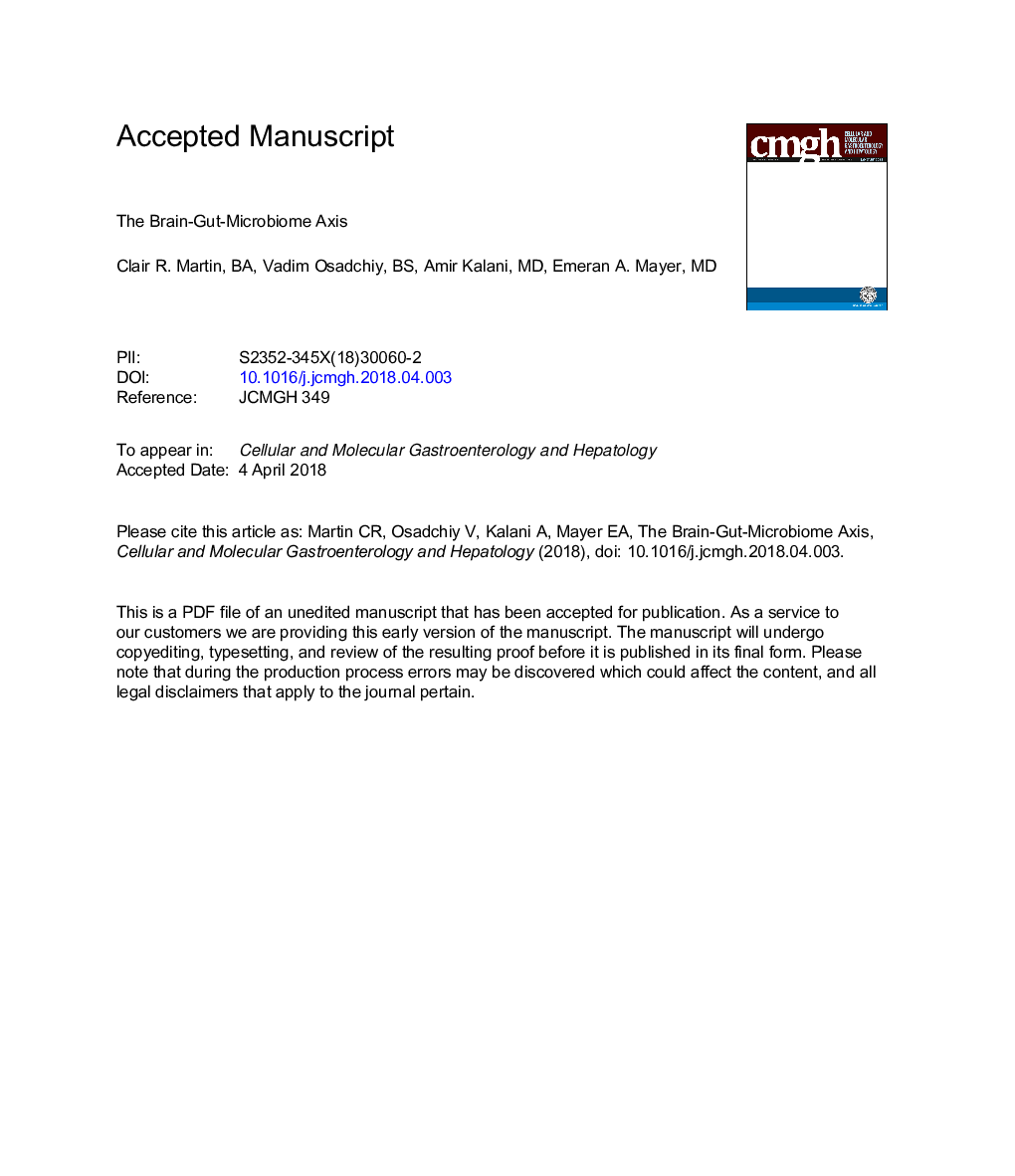| کد مقاله | کد نشریه | سال انتشار | مقاله انگلیسی | نسخه تمام متن |
|---|---|---|---|---|
| 8376039 | 1543152 | 2018 | 37 صفحه PDF | دانلود رایگان |
عنوان انگلیسی مقاله ISI
The Brain-Gut-Microbiome Axis
ترجمه فارسی عنوان
محور مغز-گلو-میکروبیومی
دانلود مقاله + سفارش ترجمه
دانلود مقاله ISI انگلیسی
رایگان برای ایرانیان
کلمات کلیدی
Secondary bile acidGLP-1FFAR5-HTIBSSCFAEECFGFFXRTrpECCGPRSPFBGMLPSTGR5G-protein–coupled receptorfarnesoid X receptor - Farnesoid X گیرندهAutism spectrum disorder - اختلالات طیف اوتیسم گروهیStress - استرس یا فشار روانیshort-chain fatty acid - اسید چرب کوتاه مدتgerm-free - بدون میکروبTryptophan - تریپتوفانspecific-pathogen-free - خاص بدون پاتوژنAutonomic nervous system - دستگاه عصبی خودمختار یا خودگردان یا اتونومCNS - دستگاه عصبی مرکزیGastrointestinal - دستگاه گوارشANS - سالBBB - سد خونی مغزیSerotonin - سروتونینenterochromaffin cell - سلول انتروکروموفینEnteroendocrine cell - سلولهای انتروندوکریirritable bowel syndrome - سندروم روده تحریک پذیر، کولیت عصبیcentral nervous system - سیستم عصبی مرکزیfibroblast growth factor - فاکتور رشد فیبروبلاستlipopolysaccharide - لیپوپلی ساکاریدBlood-brain barrier - مانع خون مغزیIntestinal permeability - نفوذپذیری رودهASD - نقص سپتوم یا دیوارهی دهلیزیglucagon-like peptide-1 - پپتید 1-گلوکاگون-مانندfree fatty acid receptor - گیرنده اسید چرب آزاد
ترجمه چکیده
مطالعات پیش از مواجهه و بالینی، تعامل دو طرفه را در محور مغز-میکروبیوم نشان داده اند. میکروب های روده ای از طریق حداقل سه کانال موازی و متقابل، شامل مکانیسم های عصبی، غدد درون ریز و ایمن سازی، به سیستم عصبی مرکزی ارتباط می یابند. مغز می تواند بر ساختار اجتماعی و عملکرد میکروبیوتایپ روده از طریق سیستم عصبی اتوایمی تأثیر بگذارد، از طریق تغییر مکان حرکتی رودهای منطقه، انتقال و ترشح روده و نفوذ پذیری روده و به طور بالقوه از طریق ترشح لومینایی هورمون هایی که مستقیما به بیان بیان ژن میکروبی مدول می کنند، تأثیر می گذارد. یک مدل بیولوژیکی سیستم پیشنهاد شده است که حلقه های اتصال دایره ای را در میان میکروبیوم مغز، روده، و روده قرار می دهد و در آن هرگونه اختلال در هر سطح می تواند در تمامی مدارها اختلال ایجاد کند. مجموعه ای از مشاهدات تا حد زیادی پیش از موعد، تغییرات در ارتباطات مغز-میکروبیوم در پاتوژنز و پاتوفیزیولوژی سندرم روده تحریک پذیر، چاقی و چندین اختلال روانپزشکی و عصبی را نشان می دهد. تحقیقات ادامه می دهد وعده شناسایی اهداف جدید درمانی و ایجاد استراتژی های درمان را برای مقابله با برخی از بیماری های ناتوان کننده، پر هزینه و فقیر را در نظر می گیرد.
موضوعات مرتبط
علوم زیستی و بیوفناوری
بیوشیمی، ژنتیک و زیست شناسی مولکولی
بیوشیمی، ژنتیک و زیست شناسی مولکولی (عمومی)
چکیده انگلیسی
Preclinical and clinical studies have shown bidirectional interactions within the brain-gut-microbiome axis. Gut microbes communicate to the central nervous system through at least 3 parallel and interacting channels involving nervous, endocrine, and immune signaling mechanisms. The brain can affect the community structure and function of the gut microbiota through the autonomic nervous system, by modulating regional gut motility, intestinal transit and secretion, and gut permeability, and potentially through the luminal secretion of hormones that directly modulate microbial gene expression. A systems biological model is proposed that posits circular communication loops amid the brain, gut, and gut microbiome, and in which perturbation at any level can propagate dysregulation throughout the circuit. A series of largely preclinical observations implicates alterations in brain-gut-microbiome communication in the pathogenesis and pathophysiology of irritable bowel syndrome, obesity, and several psychiatric and neurologic disorders. Continued research holds the promise of identifying novel therapeutic targets and developing treatment strategies to address some of the most debilitating, costly, and poorly understood diseases.
ناشر
Database: Elsevier - ScienceDirect (ساینس دایرکت)
Journal: Cellular and Molecular Gastroenterology and Hepatology - Volume 6, Issue 2, 2018, Pages 133-148
Journal: Cellular and Molecular Gastroenterology and Hepatology - Volume 6, Issue 2, 2018, Pages 133-148
نویسندگان
Clair R. Martin, Vadim Osadchiy, Amir Kalani, Emeran A. Mayer,
